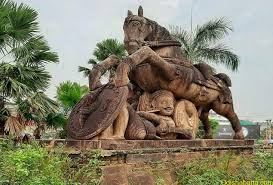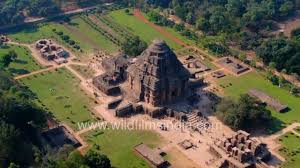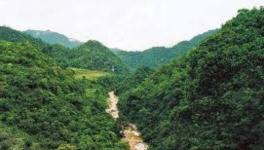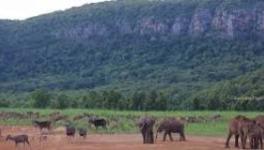Odisha: Perils of Taking Nature for Granted in the Name of ‘Beautification’

“Trees have the biggest potential to tackle the climate crisis. But in Odisha they have become the first victims of development”.
This is a statement tabled in the Odisha Assembly some months ago.
It requires no mention of where we all are heading in Odisha. A total of 1.85 crore trees have been felled for road expansion works in a decade and undisputedly Odisha is one of the worst hit states by the heat wave and climate disorder.
Be it beautification or construction activities, a mindless race has been going on to raze trees dating back to a decade or more.
This senseless exercise is made worse by the builder mafia’s close nexus with the powers that be.
Ostensibly, this “unholy nexus” has gone hyper and is bulldozing the existing ruins of nature as a whole.
Cities apart, this disproportionate greed for development is not ready to spare even the precincts of heritage sites by denuding the surrounding green foliage or trees that play a vital role in breathing life into the environment.
Odisha’s Sun Temple at Konark is a World Heritage Site that has remained a sentinel of glory and archaeological marvel. The temple was built in 1250 CE by King Narasimhadeva I of the Eastern Ganga dynasty.
The Sun Temple is a giant stone chariot dedicated to the Hindu sun god, Surya. It is located in the town of Konark on the coast of the Bay of Bengal, and was declared a UNESCO World Heritage Site in 1984.
This Konark Sun Temple was once close to the Bay of Bengal when the tides used to touch its periphery. However, the sea has drifted almost 3 kilometres back over centuries, but the Konark temple still stands where it was for the past several centuries.

Once cushioned by lush green surroundings, down the decades the temple has suffered the menace of the development with trees standing as sentries against the tidal oxidisation having gradually vanished.
The majestic Sun Temple is not just a symbol of architectural brilliance but also a sanctuary of natural beauty. However, the recent decision to cut down 875 trees in the name of beautification is deeply concerning.
Trees purify the air, provide shade, and support countless species. Cutting down these 875 trees would not only disrupt the delicate ecological balance but also tarnish the serene, green landscape that Konark is known for.
Beautification does not mean obliteration of something that is essential. True progress lies in preserving our natural heritage while enhancing the area sustainably. Instead of removing trees, can we not integrate them into the beautification plan?
Konark is a living symbol of harmony between humanity and nature. There is a need to protect this harmony for future generations.
State capital Bhubaneswar, showcased as a Smart City, has by now many dark underbellies, as many alternative attempts being made by the state government appear vacuous.
To the north of Bhubaneswar, a place called Anand Bana has been created. Although a good initiative, it is visibly bereft of a few things. The city is slowly being eaten up by the concrete monster.
“They should be planning to plant trees which can actually give shade to people on both sides of the roads, instead of planting decorative plants.” Harekrushna Satpathy, an environmental activist, told NewsClick.
Disturbingly, the administration is busy planting decorative trees and gardens on major junctions, roads, squares that do not serve any purpose of providing shade.
“Anyone who has seen Bhubaneswar in the past two decades would agree with the large scale of deforestation it has gone through. For instance, there used to be a huge Banyan tree in the Master Canteen Square in the heart of the state capital years ago, which has been replaced with a statue. Most of it has been wiped out” said Satpathy.
The surrounding areas of Chandaka, nestled with the Chandaka Elephant Sanctuary, have also been deprived of forest cover to build a two-lane Bharatpur road.
There have been pretty gardens and lights have been planted in the middle of the lanes, which serve no purpose except for “beautification”.

Only people conscious of wildlife conservation realise what impact this beautification with lights would have on the inmates of the sanctuary.
“Given a chance, this government will construct a highway right inside the elephant sanctuary,” A K Mishra, a retired forest officer of the Chandaka Sanctuary, lamented once while talking to this reporter. Today, Mishra’s fears have become a reality with the sanctuary as well as its surrounding areas facing the nightmare of erratic encroachments due to construction activities.
The biggest problem of Bhubaneswar and elsewhere is not the ruling apparatus but the debilitated mindset of people at large who never raise their voice against these violations.
The one problem with the people in Bhubaneswar is that they care least about the environment and don't do much in their capacity to oppose these moves by the government. Nature has already started warning people.
“Signs of decay are visible. One does not even find the population of insects humming during sunset, and ants are seen rarely, foraging the food particles even inside houses, which is unbelievable. Where are the crows and the vultures?” adds Satpathy.
The writer is a freelancer based in Odisha.
Get the latest reports & analysis with people's perspective on Protests, movements & deep analytical videos, discussions of the current affairs in your Telegram app. Subscribe to NewsClick's Telegram channel & get Real-Time updates on stories, as they get published on our website.
























